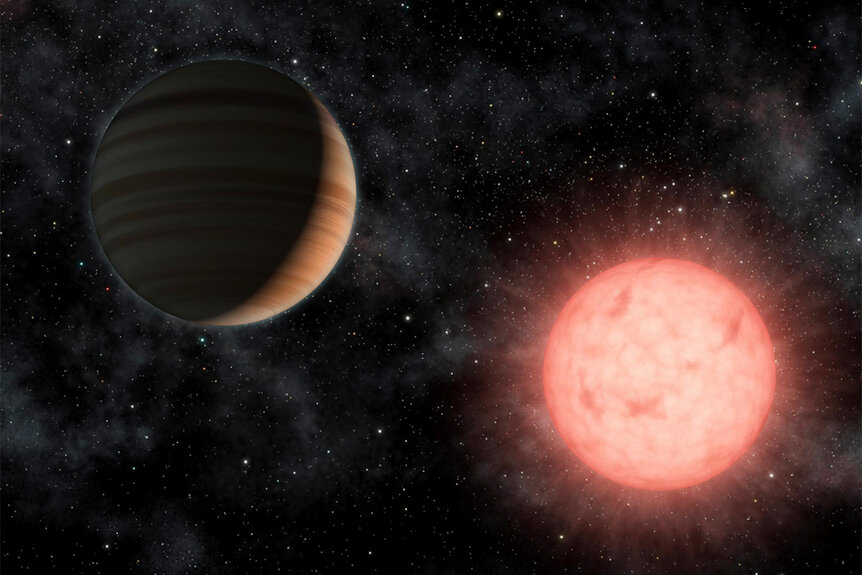Create a free profile to get unlimited access to exclusive videos, sweepstakes, and more!
Astronomers find a “forbidden planet” orbiting an impossibly tiny star
We're going to have to redefine impossible.

Picture this: You’re an interstellar explorer on a colony ship headed to Proxima Centauri b, a star roughly 4.2 light years from Earth. You expect to wake up on the surface of your new home, ready to take your first steps beneath an alien sun, having slept soundly for the duration of the journey. Instead, you’re awoken to a damaged ship, a sizable chunk of the crew missing and presumed dead, and a year left on the travel clock. That’s the situation for the crew of the Ark One, the intrepid explorers and humanity’s last hope, which make up the cast of SYFY’s latest science fiction adventure, The Ark.
Survival would be your primary concern, but if you can make it, if you can hold fast until you reach another star, you’ll be a witness to wonders no other human has ever beheld up close. One such wonder was recently discovered, not around Proxima Centauri b, but around a much more distant star called TOI-5205.
RELATED: 'The Ark' co-creator Jonathan Glassner says he 'could write a whole show' on the subject of cloning
The star, which lies roughly 283 light years from here, is considerably smaller than the Sun and has a correspondingly lower temperature. The star is so small and faint that it can’t be seen with the naked eye but it’s actually representative of most of the stars in our galaxy. Astronomers estimate that nearly three quarters of the stars in the Milky Way are red dwarfs not too dissimilar from TOI-5205. Owing to their abundance, it’s believed that the majority of planets in the Milky Way orbit this sort of star, but our models suggested that gas giants would be unlikely to form around them. Those notions are now being challenged by the discovery of a gas giant roughly the size of Jupiter orbiting TOI-5205. The discovery was carried out by a team of astronomer’s led by Shubham Kanodia from the Carnegie Institution for Science and published in The Astronomical Journal.
This isn’t the first time we’ve found a gas giant around a red dwarf star, but it is the first time we’ve found one around a star so small. TOI-5205’s mass is estimated to be only about four times that of Jupiter. For comparison, the Sun is roughly a thousand times more massive than Jupiter. This is a strange pairing, indeed. So strange, in fact, that astronomers are questioning the existing models of planetary formation.
If you dial back the clock far enough, you’ll find that planets ultimately derive from the same source material as their parent stars. In any star-forming region, the star is going to suck up the bulk of available material, leaving the dregs spinning in a protoplanetary disc. Once the star has formed, the leftover material has a limited time to form into planets before the gas and dust is scattered by the stellar winds. Because smaller stars necessarily formed from smaller initial material stores, the planets they support are expected to be smaller on average. Based on what we know so far, or what we think we know, TOI-5205 shouldn’t have had enough material or enough time to form a Jupiter-sized planet. And yet, there they are.
“TOI-5205b’s existence stretches what we know about the disks in which these planets are born. In the beginning, if there isn’t enough rocky material in the disk to form the initial core, then one cannot form a gas giant planet. And at the end, if the disk evaporates away before the massive core is formed, then one cannot form a gas giant planet. And yet TOI-5205b formed despite these guardrails. Based on our nominal current understanding of planet formation, TOI-5205b should not exist; it is a 'forbidden' planet,” Kanodia said, in a statement.
RELATED: Bring a towel, because the Hitchhikers’ Guide to hot Jupiters now exists
Astronomers identified the distant exoplanet using NASA’s Transiting Exoplanet Survey Satellite (TESS), which detects exoplanets by measuring the dimming as they pass between us and their parent star. Typically, exoplanets block less than a percent of a planet’s total luminosity as they transit, but TOI-5205b blocked approximately 7% of its parent star’s light. Astronomers noted that the incredible large dimming effect, a measure known as transit depth, makes it a perfect candidate for future observations.
Additional study, including observations by NASA’s JWST, could reveal information about the planet’s atmospheric composition and maybe even provide some answers about how it broke the cosmic rules to form in the first place.
If only we could hop on a ship and go check it out ourselves. Live out your interstellar fantasies vicariously with The Ark! New episodes air Wednesdays at 10 p.m. ET on SYFY, and stream on Peacock the next day!































